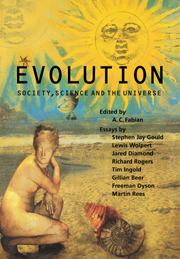Book contents
- Frontmatter
- Contents
- Introduction
- 1 On Transmuting Boyle's Law to Darwin's Revolution
- 2 The Evolution of Cellular Development
- 3 The Evolution of Guns and Germs
- 4 The Evolution of London
- 5 The Evolution of Society
- 6 The Evolution of the Novel
- 7 The Evolution of Science
- 8 The Evolution of the Universe
- Notes on Contributors
- Acknowledgements
- Index
8 - The Evolution of the Universe
Published online by Cambridge University Press: 25 January 2010
- Frontmatter
- Contents
- Introduction
- 1 On Transmuting Boyle's Law to Darwin's Revolution
- 2 The Evolution of Cellular Development
- 3 The Evolution of Guns and Germs
- 4 The Evolution of London
- 5 The Evolution of Society
- 6 The Evolution of the Novel
- 7 The Evolution of Science
- 8 The Evolution of the Universe
- Notes on Contributors
- Acknowledgements
- Index
Summary
Cosmologists study evolution on the grandest scale of all. They aim to set our earth and our solar system in an evolutionary scheme stretching right back to the formation of the Milky Way galaxy – right back even to a so-called ‘Big Bang’ that set our entire observable universe expanding and imprinted the physical laws that govern it.
Evolution within our galaxy
Let us start with something fairly well understood – the life cycle of our sun, a typical star. About 4.5 billion years ago it condensed from an interstellar cloud, and contracted until the centre became hot enough to ignite fusion of hydrogen into helium. This process will keep it shining until, after another five billion years, the hydrogen runs out. The sun will then flare up, becoming large enough to engulf the inner planets, and to vaporize all life on earth. After this ‘red giant’ phase the inner regions contract into a white dwarf – a dense star no larger than the earth, though nearly a million times more massive.
We are quite confident about these calculations because the relevant physics has been well studied in the laboratory – atomic and nuclear physics, Newtonian gravity and so forth. Astrophysicists can just as easily compute the life cycles of stars with half the sun's mass, or twice, four times, etc. Heavier stars burn brighter, and trace out their life cycle more quickly.
Stars live so long compared to astronomers that we are granted just a single ‘snapshot’ of each star's life. But we can test our theories, by looking at the whole population of stars.
- Type
- Chapter
- Information
- EvolutionSociety, Science and the Universe, pp. 136 - 160Publisher: Cambridge University PressPrint publication year: 1998

